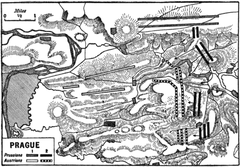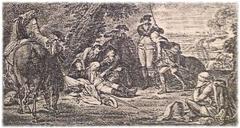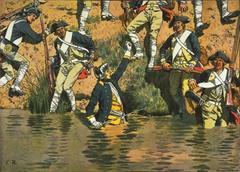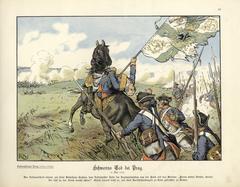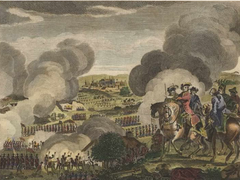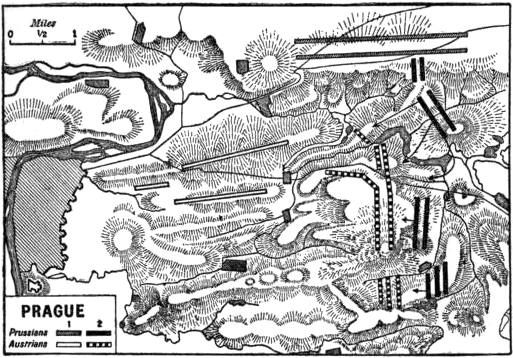
Complete Guide to Visiting Battle of Prague Sites in Prague, Czech Republic: Tickets, Hours, and Attractions
Date: 14/06/2025
Introduction
Prague’s history as a crossroads of European power is vividly reflected in its pivotal military episodes, collectively known as the Battle of Prague. These iconic confrontations during the Thirty Years’ War, the War of Austrian Succession, and the Seven Years’ War shaped not only the city’s destiny but also the broader European landscape. The Czech capital’s architectural gems, atmospheric squares, and renowned museums stand as silent witnesses to these turbulent times.
This comprehensive guide provides an in-depth look at the historical significance of the Battle of Prague, the cultural and national impact on the city, and practical information for visitors—including tickets, opening hours, accessibility, and travel tips. Whether you are a passionate history buff, a curious traveler, or a cultural explorer, this guide will help you discover the best of Prague’s battle sites and plan an immersive, educational visit.
For background and further reading, see these resources: (examples.tely.ai), (stefanov.no-ip.org).
Table of Contents
- Introduction
- Historical and Political Context
- The Thirty Years’ War: 1648 Battle of Prague
- The War of Austrian Succession: 1741–1742
- The Seven Years’ War: 1757 Battle of Prague
- Impact on Prague and Central Europe
- Cultural and National Legacy
- Top Battle of Prague Sites to Visit
- Practical Visitor Information
- Frequently Asked Questions (FAQs)
- Suggested Itinerary
- Conclusion
- References and Further Reading
Historical and Political Context
Prague’s status as a major European city placed it at the center of several critical military and religious conflicts. The city’s role in the Holy Roman Empire, marked by the Protestant Reformation and Catholic Counter-Reformation, led to repeated struggles for control. The 1618 Defenestration of Prague sparked the Thirty Years’ War, setting the stage for decades of warfare and shaping the city’s identity (prague.org).
The Thirty Years’ War: 1648 Battle of Prague
The Thirty Years’ War (1618–1648) devastated Central Europe, with Prague suffering sieges and occupations. In 1648, Swedish forces attacked, capturing the city’s western districts but failing to take the Old Town thanks to the determined defense by citizens and remaining imperial troops. This last battle of the war became a symbol of Czech resilience. The Peace of Westphalia, signed that year, ended the conflict and laid the groundwork for modern concepts of sovereignty and religious tolerance (examples.tely.ai).
The War of Austrian Succession: 1741–1742
Prague’s strategic importance continued during the War of Austrian Succession, when French and Bavarian troops captured the city in 1741. Austrian forces reclaimed it the following year, underscoring Prague’s significance in the balance of European power (examples.tely.ai).
The Seven Years’ War: 1757 Battle of Prague
The Battle of Prague (May 6, 1757) was a turning point in the Seven Years’ War. Frederick the Great’s Prussian forces, despite being outnumbered, used the innovative “oblique order” tactic to defeat the Austrians outside Prague (stefanov.no-ip.org). Although the Prussians besieged the city, they ultimately withdrew after suffering heavy losses and facing Austrian reinforcements. The battle and siege brought hardship to Prague’s residents, but also reinforced the city’s reputation for resilience (vonbrowne.blogspot.com; czechia-prague.com).
Impact on Prague and Central Europe
The repeated conflicts brought destruction, population displacement, and economic hardship to Prague. Yet, these adversities fostered a strong sense of identity and unity among its inhabitants. The city’s experience during successive wars influenced military strategies and the political development of Central Europe, with Prague’s defenses and fortifications standing as lasting testaments to its turbulent past (examples.tely.ai).
Cultural and National Legacy
Despite its war-torn history, Prague continued to flourish as a center of art, music, and intellectual life. The battles are commemorated through monuments, festivals, and local traditions, reinforcing the city’s role as a symbol of Czech resilience and spirit (examples.tely.ai).
Top Battle of Prague Sites to Visit
Prague Castle (Pražský hrad)
- Significance: Site of the 1618 Defenestration and the 1648 defense.
- Opening Hours: Castle grounds 6:00 AM–10:00 PM; ticketed areas (such as St. Vitus Cathedral, Old Royal Palace) 9:00 AM–5:00 PM.
- Tickets: Full circuit approx. 350 CZK; discounts for students/seniors.
- Accessibility: Wheelchair accessible in most areas; some historic sections have stairs.
- Tip: Guided tours recommended for detailed history.
Charles Bridge (Karlův most)
- Significance: Key crossing during battles, especially in 1648.
- Opening Hours: Open 24/7.
- Tickets: Free entry.
- Accessibility: Cobblestone surface; partial accessibility.
Old Town Square (Staroměstské náměstí) & Old Town
- Significance: Defensive stronghold and site of resistance.
- Opening Hours: Public area, always accessible.
- Tickets: Free; Old Town Hall Tower approx. 250 CZK.
- Accessibility: Mostly accessible; cobblestones in places.
Powder Tower (Prašná brána)
- Significance: Defensive city gate damaged during conflict.
- Opening Hours: 10:00 AM–6:00 PM.
- Tickets: Approx. 100 CZK.
- Accessibility: Steep stairs; not wheelchair accessible.
Lesser Town (Malá Strana) & Hradčany
- Significance: Occupied and looted in 1648.
- Opening Hours: Public area.
- Tickets: Free; some churches require entrance fees.
- Accessibility: Moderate; cobbled streets.
Strahov Monastery (Strahovský klášter)
- Significance: Looted in 1648; houses famous library.
- Opening Hours: Library 9:00 AM–6:00 PM.
- Tickets: Approx. 150 CZK.
- Accessibility: Some uneven flooring.
Vyšehrad Fortress
- Significance: Strategic defense; not directly involved in 1648 but important context.
- Opening Hours: Grounds open 24/7; museum hours vary.
- Tickets: Free for grounds; museum approx. 100 CZK.
- Accessibility: Mostly accessible.
Army Museum Žižkov
- Overview: Extensive exhibits on Czech military history, including the Seven Years’ War.
- Opening Hours: Tuesday–Sunday 10:00 AM–6:00 PM.
- Tickets: Free entry.
- Accessibility: Fully accessible.
- Website: Army Museum Žižkov
National Museum
- Overview: Artifacts from the Thirty Years’ War and other conflicts.
- Opening Hours & Tickets: Vary by exhibit; see official site for details.
Practical Visitor Information
- Tickets & Hours: Book online to avoid lines. Most sites accept credit cards.
- Best Time to Visit: Spring and autumn for mild weather and fewer crowds; summer is busiest; winter offers a quiet experience.
- Getting Around: Prague’s city center is walkable. Use trams or metro for longer distances.
- Accessibility: Most major sites are wheelchair accessible; historic sites may have uneven terrain.
- Guided Tours: Highly recommended for rich historical context; specialized tours available for military history.
Frequently Asked Questions (FAQs)
Q: Where can I see exhibits about the Battle of Prague?
A: The Army Museum Žižkov and National Museum both feature extensive exhibits on the city’s military past.
Q: Are guided tours available?
A: Yes, many local operators offer specialized walking tours focusing on the battles and military history.
Q: What are the opening hours for Prague Castle?
A: Castle grounds are open daily 6:00 AM–10:00 PM; ticketed areas typically 9:00 AM–5:00 PM.
Q: Is Charles Bridge free to visit?
A: Yes, Charles Bridge is open to the public at all times and does not require a ticket.
Q: Are the battle sites wheelchair accessible?
A: Most museums and modern attractions are accessible; some historic sites have stairs or cobblestones.
Q: How do I get to Vyšehrad Fortress?
A: Take tram or metro; it’s a short trip from the city center.
Suggested Itinerary for Battle of Prague Enthusiasts
- Morning: Start at Prague Castle and St. Vitus Cathedral.
- Midday: Stroll across Charles Bridge, observing plaques and statues.
- Afternoon: Explore Old Town Square, climb the Old Town Hall Tower, and visit the Powder Tower.
- Evening: Wander through Malá Strana and Hradčany; tour the Strahov Monastery.
- Optional: End the day at Vyšehrad for sunset views.
- Bonus: Deepen your knowledge at Army Museum Žižkov.
Visual and Multimedia Resources
Conclusion
Exploring the Battle of Prague sites brings history to life, offering visitors a unique chance to experience the resilience and legacy of this remarkable city. From the powerful fortifications of Prague Castle to the poignant memorials and engaging museum exhibits, these landmarks invite you to walk in the footsteps of those who shaped European history. Plan ahead for tickets and opening hours, take advantage of guided tours, and immerse yourself in the stories and monuments that define Prague’s enduring spirit.
For more travel tips and personalized experiences, download the Audiala app and follow us on social media for the latest updates on events and tours.
References and Further Reading
- The Battle of Prague: Historical Significance and Visitor Guide to Prague’s Historic Sites
- Significance of the Battle of Prague
- Battle of Prague Historical Sites: Visiting Hours, Tickets & Travel Tips for Prague’s Key Landmarks
- Army Museum Žižkov
- Prague History Overview
- Battle of Prague Commemoration
- Prague.org: Prague History
- CTDOTS: Prague Sites
- Story of Prague: Charles Bridge
- Hello Jetlag: Prague Travel Tips
- Tripindicator: Prague Attractions Map
- Prague Tourist Information
- DayHist: Battle of Prague 1757
- British Battles: Battle of Prague
